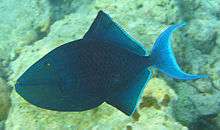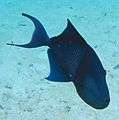Redtoothed triggerfish
| Redtoothed triggerfish | |
|---|---|
 | |
Not evaluated (IUCN 3.1) | |
| Scientific classification | |
| Kingdom: | Animalia |
| Phylum: | Chordata |
| Class: | Actinopterygii |
| Order: | Tetraodontiformes |
| Family: | Balistidae |
| Genus: | Odonus Gistel, 1848 |
| Species: | O. niger |
| Binomial name | |
| Odonus niger Rüppell, 1836 | |
Odonus niger, also known as the Redtoothed triggerfish, is a triggerfish of the tropical Indo-Pacific area, and the sole member of its genus.[1] Some other common names include Blue Triggerfish, Redfang Triggerfish, Redtoothed filefish, and Niger Triggerfish.
Description
Redtoothed triggerfish are normally deep purple with bluish-green markings on their heads and glowing light blue margins on the tail lobes and fins. Just like other fish in the Balistidae family, the tail is lyre-shaped. The mouth of the triggerfish seems to be grinning and it maintains tiny red teeth that are needle sharp with two teeth in the upper jaw which can be seen when its mouth is closed. These triggerfish are one of the more peaceful triggers in the family but can become threatening with age and can perform a grunting-type sound. They have the ability to change their colour depending on their mood, food, feeding and water quality from purple to blue and to bluish-green.
Their pectoral fins are quite small; as a result they steer mostly with their dorsal and anal fins, which makes them very maneuverable, and they also use these fins to move with an exotic type of propulsion reminiscent of a propellor. It is one of the most singular swimming styles in the ocean.
Behavior and Diet
Redtoothed Triggerfishes love to inhabit reef channels or long slopes that have strong water currents, but how do they survive? They hide under between rocks and crevices so they don’t get blown away from the water currents. They also like to live in the coastal shallow inshore waters at depths of around 30 - 100 feet (9 - 30 meters). Redtoothed Triggers are mostly planktivorous eaters in the Balistidae family. In the ocean, they can form schools and normally feed on zooplankton which gets blown through by the currents and sponges which is another part of their menu. They are also known to be carnivorous which means they eat many different types of meaty foods such as krill, clams, squid, urchins, small fish, and petite fish.
 Group of Redtoothed Triggerfish feeding on plankton.
Group of Redtoothed Triggerfish feeding on plankton. The red teeth are its distinguishing feature.
The red teeth are its distinguishing feature.
Range
The Redtoothed Triggerfish species live in the widespread Indo-Pacific Ocean and Red Sea. They are found at the African east coast to Marquesas and Society islands. You can also find them as far north as Southern Japan and as far south as the Great Barrier Reef in Australia.
Breeding
These fish have distinct pairing. They meet at mating grounds where males set up their territories. Odonus Nigers build nests to lay their eggs in. The females take care of the eggs while both of them guard the eggs waiting for hatching. While they can breed in the wild, they can not breed in aquariums.
In the Aquarium
Usually, the Niger Triggerfish that you find for sale are only juveniles so they are small. You need to keep in mind that these triggerfish can grow up to be 20 inches (51cm) in length which makes them quite a large triggerfish, so you will need a big aquarium to keep them in. Unlike some other Triggerfishes, this one can grow into its full adult size in a short amount of time if it is cared for properly. You will at least need a 70-80 gallon tank to house one because they need room to move, grow, and keep safe. Unlike the other triggerfish species, these triggerfish are friendly and peaceful towards their tankmates. So you can keep more than just one Redtoothed Triggerfish as long as they are added as juveniles at the same time. This fish will eat just about everything in the wild and will do the same in an aquarium. It’s possible that a Niger trigger would eat any slow moving fish, large fish, and any sessile invertebrate type. Odonus nigers will usually adapt to aquarium fare and will eat a number of applicable sized frozen and fresh meaty foods as well as dry pellets, you need to feed them at least 2 or 3 times a day but be careful when you feed them because they can deliver a painful bite which results in blood coming out, so use caution when you put your hand in the tank.
References
| Wikimedia Commons has media related to Odonus niger. |
- ↑ Matsuura, K. (2014): Taxonomy and systematics of tetraodontiform fishes: a review focusing primarily on progress in the period from 1980 to 2014. Ichthyological Research, 62 (1): 72-113.